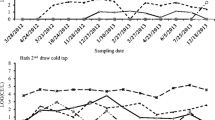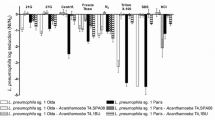Abstract
The Mycobacterium avium complex (MAC) is a group of opportunistic human pathogens that may thrive in engineered water systems. MAC has been shown to occur in drinking water supplies based on surface water, but less is known about the occurrence and persistence of live cells and DNA in public hot water systems based on groundwater. In this study, we examined the occurrence of MAC in hot water systems of public day care centers and determined the persistence of live and dead M. avium cells and naked DNA in model systems with the modern plumbing material cross-linked polyethylene (PEX). The occurrence of MAC and co-occurrence of Legionella spp. and Legionella pneumophila were determined using cultivation and qPCR. Co-occurrences of MAC and Legionella were detected in water and/or biofilms in all hot water systems at temperatures between 40 and 54 °C. Moderate correlations were observed between abundance of culturable MAC and that of MAC genome copies, and between MAC and total eubacterial genome copies. No quantitative relationship was observed between occurrence of Legionella and that of MAC. Persistence in hot water of live and dead M. avium cells and naked DNA was studied using PEX laboratory model systems at 44 °C. Naked DNA and DNA in dead M. avium cells persisted for weeks. Live M. avium increased tenfold in water and biofilms on PEX. The results suggest that water and biofilms in groundwater-based hot water systems can constitute reservoirs of MAC, and that amplifiable naked DNA is relatively short-lived, whereas PEX plumbing material supports persistence and proliferation of M. avium.



Similar content being viewed by others
References
Aboagye G, Rowe MT (2011) Occurrence of Mycobacterium avium subsp. paratuberculosis in raw water and water treatment operations for the production of potable water. Water Res 45:3271–3278
Bagh KL, Albrechtsen HJ, Arvin E, Ovesen K (2004) Distribution of bacteria in a domestic hot water system in a Danish apartment building. Water Res 38:225–235
Burnsed LJ, Hicks LA, Smithee LMK, Fields BS, Bradley KK, Pascoe N, Richards SM, Mallonee S, Littrell L, Benson RF, Moore MR, The Legionellosis Outbreak Investigation Team (2007) A large travel-associated outbreak of legionellosis among hotel guests: utility of the urine antigen assay in confirming pontiac fever. Clin Infect Dis 44:222–228
Bustin SA, Benes V, Garson JA, Hellemans J, Huggett J, Kubista M, Mueller R, Nolan T, Pfaffl MW, Shipley GL, Vandesompele J, Wittwer CT (2009) The MIQE guidelines: minimum information for publication of quantitative real-time PCR experiments. Clin Chem 55:611–622
Carson LA, Petersen NJ, Favero MS, Aguero SM (1978) Growth characteristics of atypical mycobacteria in water and their comparative resistance to disinfectants. Appl Environ Microbiol 36:839–846
Cassidy PM, Hedberg K, Saulson A, McNelly E, Winthrop KL (2009) Nontuberculous mycobacterial disease prevalence and risk factors: a changing epidemiology. Clin Infect Dis 49:124–129
Cazalet C, Gomez-Valero L, Rusniok C, Lomma M, Dervins-Ravault D, Newton HJ, Sansom FM, Jarraud S, Zidane N, Ma L, Bouchier C, Etienne J, Hartland EL, Buchrieser C (2010) Analysis of the Legionella longbeachae genome and transcriptome uncovers unique strategies to cause Legionnaires’ disease. PLoS Genet 6(2):e1000851
Chang B, Sugiyama K, Taguri T, Amemura-Maekawa J, Kura F, Watanabe H (2009) Specific detection of viable Legionella cells by combined use of photoactivated ethidium monoazide and PCR/real time PCR. Appl Environ Microbiol 75:147–153
Declerck P, Behets J, Margineanu A, Hoef V, De Keersmaecker B, Ollevier F (2009) Replication of Legionella pneumophila in biofilms of water distribution pipes. Microbiol Res 164:593–603
DS 3029 (2001) Environmental quality—Enumeration of Legionella—Concentration and colony count on solid medium—Spread plate method. Danish Standards Association, Copenhagen, Denmark
Falkinham JO III, Nichols G, Bartram J, Dufour A, Portaels F (2004) Natural ecology and survival in water of mycobacteria of potential public health significance. In: Pedley, Bartram, Rees, Dufour, Cotruvo (eds) Pathogenic Mycobacteria in water: a guide to public health consequences, monitoring and management. IWA Publishing, London, pp 15–25
Falkinham JO III (2009) Surrounded by mycobacteria: nontuberculous mycobacteria in the human environment. J Appl Microbiol 107:356–367
Falkinham JO III (2011) Nontuberculous mycobacteria from household plumbing of patients with nontuberculous mycobacteria disease. Emerg Infect Dis 17:419–424
Feazel LM, Baumgartner LK, Peterson KL, Frank DN, Harris JK, Pace NR (2009) Opportunistic pathogens enriched in showerhead biofilms. PNAS 106:16393–16399
Hernández-Garduño E, Elwood RK (2010) Demographic risk factors of pulmonary colonization by non-tuberculous mycobacteria. Int J Tuberc Lung Dis 14:106–112
Inderlied CB, Kemper CA, Bermudez LE (1993) The Mycobacterium avium complex. Clin Microbiol Rev 6:266–310
ISO 6222 (1999) Water quality: Enumeration of culturable microorganisms. Colony count by inoculation in a nutrient agar culture medium. International Organization for Standardization. Geneva, Switzerland
Karakousis PC, Moore RD, Chaisson RE (2004) Mycobacterium avium complex in patients with HIV infection in the era of highly active antiretroviral therapy. Lancet Infect Dis 4:557–565
Klanicova B, Seda J, Slana I, Slany M, Pavlik I (2013) The tracing of Mycobacteria in drinking water supply systems by culture, conventional, and real time PCR. Current Microbiol 67:725–731
Klappenbach JA, Saxman PR, Cole JR, Schmidt TM (2001) rrnDB: the ribosomal RNA operon copy number database. Nucl Acid Res 29:181–184
Krøjgaard LJ, Krogfelt KA, Albrechtsen HJ, Uldum SA (2011) Cluster of legionnaires’disease in a newly built block of flats, Denmark, December 2008–January 2009. Eurosurveillance 16:1–7
Lai CC, Tan CK, Chou CH, Hsu HL, Liao CH, Huang YT, Yang PC, Luh KT, Hsueh PR (2010) Increasing incidence of nontuberculous mycobacteria, Taiwan, 2000–2008. Emerg Infect Dis 16:294–296
Lee ZM, Bussema C, Schmidt TM (2009) rrnDB: documenting the number of rRNA and tRNA genes in bacteria and archaea. Nucl Acid Res 37:489–493
Lehtola MJ, Torvinen E, Kusnetsov J, Pitkänen T, Maunula L, von Bonsdorff CH, Martikainen PJ, Wilks SA, Keevil CW, Miettinen IT (2007) Survival of Mycobacterium avium, Legionella pneumophila, Escherichia coli, and Calicivirases in drinking water-associated biofilms grown under high-shear turbulent flow. Appl Environ Microbiol 73:2854–2859
Marciano-Cabral F, Jamerson M, Kaneshiro ED (2010) Free-living amoebae, Legionella and Mycobacterium in tap water supplied by a municipal drinking water utility in the USA. J Water Health 8:71–82
Mardare C, Delahay RJ, Dale JW (2013) Environmental amoebae do not support the long-term survival of virulent mycobacteria. J Appl Microbiol 114:1388–1394
Marras TK, Wallace RJ, Koth LL, Stulbarg MS, Cowl CT, Daley CL (2005) Hypersensitivity pneumonitis reaction to Mycobacterium avium in household water. Chest 127:664–671
Mathys W, Stanke J, Harmuth M, Junge-Mathys E (2008) Occurrence of Legionella in hot water systems of single-family residences in suburbs of two German cities with special reference to solar and district heating. Int J Hyg Environ Health 211:179–185
Miyamoto H, Yamamoto H, Arima K, Fujii J, Maruta K, Izu K, Shiomori T, Yoshida S (1997) Development of a new seminested PCR method for detection of Legionella species and its application to surveillance of Legionellae in hospital cooling tower water. Appl Environ Microbiol 63:2489–2494
Moore J, Kruijshaar M, Ormerod L, Drobniewski F, Abubakar I (2010) Increasing reports of non-tuberculous mycobacteria in England, Wales and Northern Ireland, 1995–2006. BMC Public Health 10:612
Mullis SN, Falkinham JO III (2013) Adherence and biofilm formation of Mycobacterium avium, Mycobacterium intracellulare, and Mycobacterium abscessus to household plumbing materials. J Appl Microbiol 115:908–914
Nadkarni MA, Martin FE, Jacques NA, Hunter N (2002) Determination of bacterial load by real-time PCR using a broad-range (universal) probe and primers set. Microbiology 148:257–266
Nichols G, Ford T, Bartram J, Dufour A, Portaels F (2004) Introduction. In: Pedley S, Bartram J, Rees G, Dufour A, Cotruvo JA (eds) Pathogenic mycobacteria in water: a guide to public health consequences, monitoring and management. IWA Publishing, London, pp 1–14
Nishiuchi Y, Tamura A, Kitada S, Taguri T, Matsumoto S, Tateishi Y, Yoshimura M, Ozeki Y, Matsumura N, Ogura H, Maekura R (2009) Mycobacterium avium complex organisms predominantly colonize in the bathtub inlets of patients’ bathrooms. Jpn J Infect Dis 62:182–186
Räsänen NHJ, Rintala H, Miettinen IT, Torvinen E (2013) Comparison of culture and qPCR methods in detection of mycobacteria from drinking water. Can J Microbiol 59:280–286
Roslev P, Bukh AS (2011) State of the art molecular markers for fecal pollution source tracking in water. Appl Microbiol Biotechnol 89:1341–1355
Standard Methods for the Examination of Water and Wastewater (2005) American Public Health Association/American Water Works Association/Water Environment Federation, 21st edn. Washington, DC
Tatchou-Nyamsi-König JA, Dailloux M, Block JC (2009) Survival of Mycobacterium avium attached to polyethylene terephthalate (PET) water bottles. J Appl Microbiol 106:825–832
Thomson RM (2010) Changing epidemiology of pulmonary nontuberculous mycobacteria infections. Emerg Infect Dis 16:1576–1583
Torvinen E, Lehtola MJ, Martikainen PJ, Miettinen IT (2007) Survival of Mycobacterium avium in drinking water biofilms as affected by water flow velocity, availability of phosphorus, and temperature. Appl Environ Microbiol 73:6201–6207
Vaerewijck MJM, Huys G, Palomino JC, Swings J, Portaels F (2005) Mycobacteria in drinking water distribution systems: ecology and significance for human health. FEMS Microbiol Rev 29:911–934
van der Wielen PWJJ, van der Kooij D (2013) Nontuberculous mycobacteria, fungi, and opportunistic pathogens in unchlorinated drinking water in the Netherlands. Appl Environ Microbiol 79:825–834
Wadowsky RM, Yee RB, Mezmar L, Wing EJ, Dowling JN (1982) Hot water systems as sources of Legionella pneumophila in hospital and nonhospital plumbing fixtures. Appl Environ Microbiol 43:1104–1110
Wang H, Edwards M, Falkinham JO III, Pruden A (2012) Molecular survey of the occurrence of Legionella spp., Mycobacterium spp., Pseudomonas aeruginosa, and amoeba hosts in two chloraminated drinking water distribution systems. Appl Environ Microbiol 78:6285–6294
Wang H, Masters S, Hong Y, Stallings J, Falkinham JO III, Edwards M, Pruden (2012) Effect of disinfectant, water age, and pipe material on occurrence and persistence of Legionella, mycobacteria, Pseudomonas aeruginosa, and two amoebas. Environ Sci Tech 46:11566–11574
Whiley H, Keegan A, Giglio S, Bentham R (2012) Mycobacterium avium complex: the role of potable water in disease transmission. J Appl Microbio 113:223–232
Williams MM, Yakrus MA, Arduino MJ, Cooksey RC, Crane CB, Banerjee SN, Hilborn ED, Donlan RM (2009) Structural analysis of biofilm formation by rapidly and slowly growing nontuberculous mycobacteria. Appl Environ Microbiol 75:2091–2098
Wilson DA, Yen-Lieberman B, Reischi U, Gordon SM, Procop GW (2003) Detection of Legionella pneumophila by real-time PCR for the MIP gene. J Clin Microbiol 41:3327–3330
Winthrop KL, McNelley E, Kendall B, Marshall-Olson A, Morris C, Cassidy M, Saulson A, Hedberg K (2010) Pulmonary nontuberculous mycobacterial disease prevalence and clinical features: an emerging public health disease. Am J Respir Crit Care Med 182:977–982
Acknowledgments
We thank Margit Paulsen for providing technical assistance and Associate Professor Niels Iversen for helpful discussions. This work was supported by the Danish Council for Strategic Research; the project SENSOWAQ—Sensors for Monitoring and Control of Water Quality; and by grants from the Obel Family Foundation.
Conflict of interest
The authors declare that they have no conflict of interest.
Author information
Authors and Affiliations
Corresponding author
Rights and permissions
About this article
Cite this article
Bukh, A.S., Roslev, P. Mycobacterium avium Complex in Day Care Hot Water Systems, and Persistence of Live Cells and DNA in Hot Water Pipes. Curr Microbiol 68, 428–439 (2014). https://doi.org/10.1007/s00284-013-0493-4
Received:
Accepted:
Published:
Issue Date:
DOI: https://doi.org/10.1007/s00284-013-0493-4




